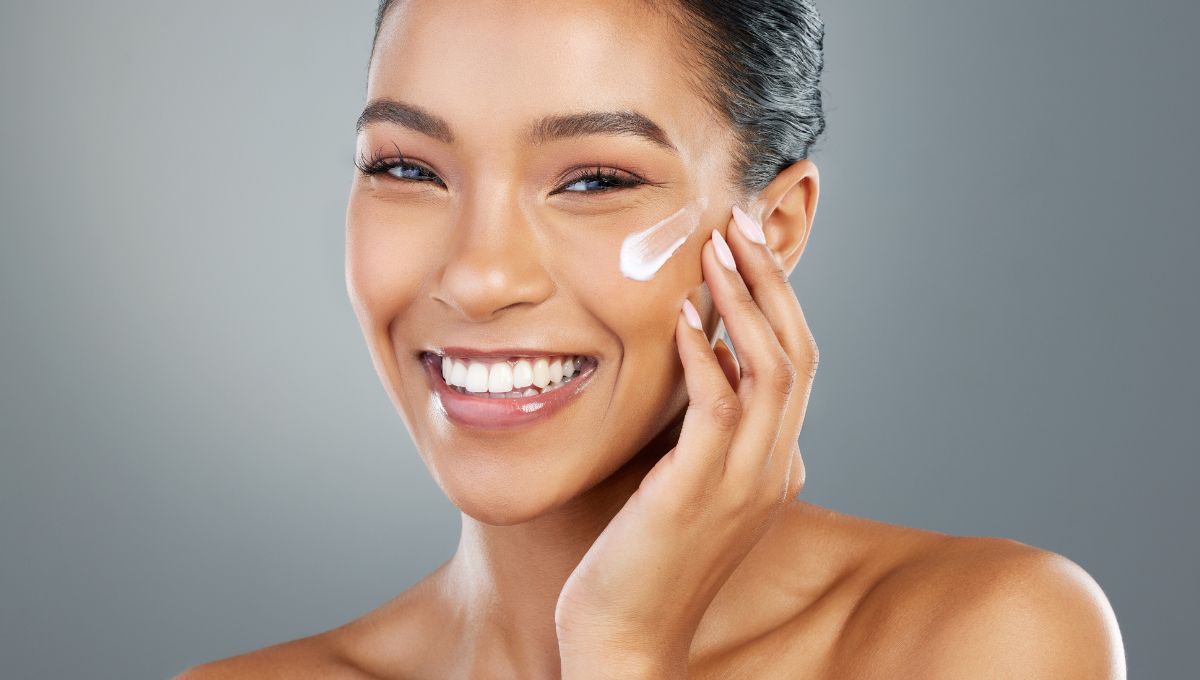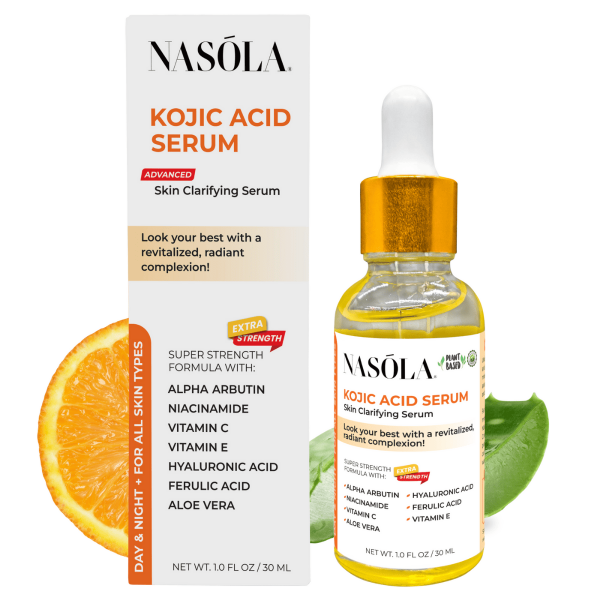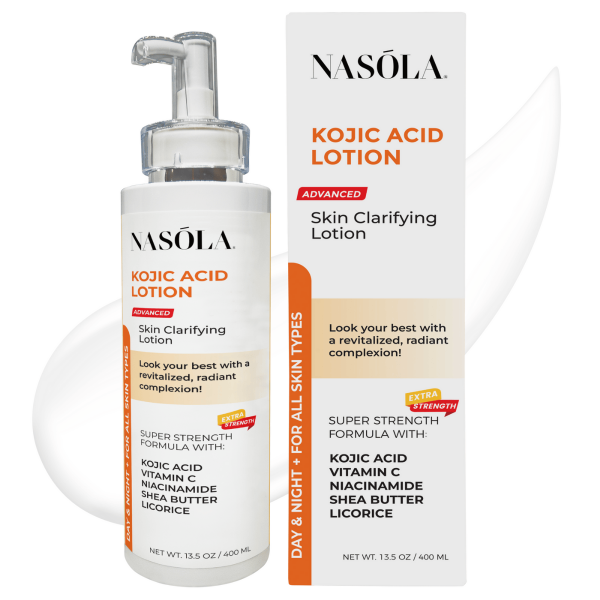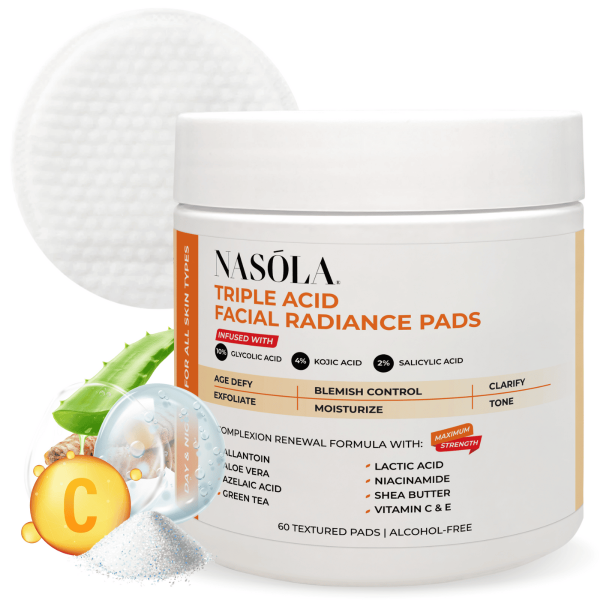Kojic acid skin lightening cream has become an absolute game-changer for anyone frustrated with stubborn dark spots, hyperpigmentation, or uneven tone that just won’t go away—no matter what they try.
Whether it’s post-acne marks, sun spots, or discoloration from hormonal changes, more and more people are reaching for gentler, plant-based solutions that still bring real results.
That’s where kojic acid shines.
Known for inhibiting melanin production, kojic acid offers proven skin-brightening power—without the harshness of synthetic bleaches.
And the demand for this powerful ingredient keeps climbing, especially in star products like Nasola Kojic Acid Cream, Nasola Kojic Acid Serum, and Nasola Kojic Acid Lotion.
But what’s so special about these formulations? And how do you know which one is right for you?
Let’s unpack it all—because brighter days (and clearer skin!) are definitely ahead.
- What is Kojic Acid Skin Lightening Cream and How Does It Work?
- Best Kojic Acid Skin Lightening Cream: What to Look For
- Kojic Acid Skin Lightening Cream Ingredients That Actually Work
- How to Use Kojic Acid Skin Lightening Cream for Best Results
- Extra Care: Combine Kojic Acid with a Consistent Skincare Regimen
- Real Talk: What NOT to Do When Using Kojic Acid Skin Lightening Cream
- Conclusion
- Frequently Asked Questions (FAQs)
What is Kojic Acid Skin Lightening Cream and How Does It Work?
Kojic acid skin lightening cream isn’t just another product cluttering your skincare shelf—it’s one with a scientific punch that gently, yet effectively, helps even out skin tone.
Derived from fungi (yep, like mushrooms), kojic acid works by preventing an enzyme called tyrosinase from producing melanin. Less melanin equals less hyperpigmentation.
It’s no surprise that skincare lovers—especially those with sensitive or easily irritated skin—are turning to kojic acid as a safer alternative to the stronger, often irritating options out there.
Let’s dig deeper into what makes it all tick.
Understanding Kojic Acid
Kojic acid emerged from Japanese rice wine fermentation—yes, sake!—and after scientists isolated it from certain fungus strains, they realized it had notable effects on melanin.
Melanin is what gives our skin its pigment, and while it’s essential, when overproduced due to sun, scars, or hormones…
Things get a little blotchy.
So how does kojic acid work?
- It blocks tyrosinase, the enzyme responsible for melanin production.
- Slows visible signs of aging like sunspots and uneven tone.
- Offers mild antioxidant benefits.
- Gently brightens existing discoloration.
Compared to skin-bleaching agents, it’s much gentler but still effective.
How Lightening Creams Differ from Other Skincare Products
You might be wondering: how’s this different from my vitamin C serum or niacinamide moisturizer?
Here’s the scoop:
- Kojic acid creams focus directly on blocking melanin production.
- They’re designed to penetrate deeper than basic moisturizers.
- Hydroquinone fades spots aggressively—kojic acid works at a slower, kinder pace.
- Unlike vitamin C, it directly targets the enzyme behind pigmentation—not just general brightness.
This makes kojic acid skin lightening cream ideal for everyday use without irritation.
Product Spotlight: Nasola® Kojic Acid Cream
The Nasola Kojic Acid Cream stands out in this space for one reason: it combines brightening with nourishment.
So many creams dry you out or leave you flaky. Not this one. Here’s what it brings to the table:
- Proven plant-based lighteners like kojic acid + niacinamide.
- Shea butter and alpha arbutin for hydration and pigment regulation.
- Gentle enough for daily use—morning or night.
- Perfect for the face, neck, and even body (hello knees and elbows!)
If you’re tired of guessing, this is one that delivers. Softly, surely… and visibly.
Best Kojic Acid Skin Lightening Cream: What to Look For

When it comes to finding the best kojic acid skin lightening cream, things can get overwhelming fast. Labels scream promises—but the real power is in the blend of ingredients, the formulation, and your skin’s unique needs.
So let’s make it simple. Here’s exactly what to look for.
Key Features of the Best Kojic Acid Skin Lightening Creams
Anyone can slap a “kojic acid” label on a tub, but not all products are equal. The best kojic acid skin lightening cream will hit these marks:
- Kojic acid concentration between 1–2% (anything higher can irritate).
- Complementary ingredients like niacinamide, glycerin, alpha arbutin.
- Soothing blends for all skin types—particularly sensitive or dry skin.
- Hydrating base like shea butter to offset drying effects.
Keep these as your North Star 👇
- Always patch test new products.
- Pick creams that double as moisturizers (your skin will thank you).
- Pick formulas with added antioxidants.
- Avoid products loaded with parabens or synthetic compounds.
Product Comparison: Why Nasola Leads the Pack
Take a stroll through the Nasola Kojic Acid Cream and Nasola Kojic Acid Lotion.
What’s the difference?
- Cream: Rich, decadent, ideal for targeted facial use or stubborn dark areas.
- Lotion: Lightweight, spreads faster—perfect for arms, thighs, or back.
Both contain kojic acid and soothing, brightening companions like niacinamide. The cream focuses more on nourishment; the lotion gives broader coverage.
Real talk: Don’t overthink it. Pick one for your face, one for your body. Pair ’em, love your glow.
Kojic Acid Skin Lightening Cream Ingredients That Actually Work
Ingredients make or break a product—and when it comes to kojic acid skin lightening cream ingredients, it’s more than buzzwords. You need synergy. That perfect blend between active ingredients and skin-loving bonuses.
Let’s peel back the label and learn what truly delivers results.
Ingredient Transparency Matters
You deserve to know exactly what’s touching your skin. Don’t be afraid to turn that jar around and scan the list.
Spotlight what really matters:
- Kojic acid as a top-five ingredient? ✔️
- Supportive hydration from things like glycerin, shea butter? Absolutely.
- Niacinamide & licorice for soothing/lightening combo? Even better.
- Minimal synthetic stabilizers or fragrances? Yes, please.
Pick transparency. Always.
Synergistic Ingredients in Nasola Products
Nasola doesn’t just toss kojic acid into a tub—it blends ingredients that enhance it.
Here’s what you’ll get:
- Niacinamide: Supports collagen, smooths fine lines.
- Alpha Arbutin: Natural melanin suppressant.
- Vitamin E: Antioxidant powerhouse, reduces redness.
- Shea Butter: Locks in moisture.
- Licorice Root Extract: Calms inflammation, brightens tone.
They work better together. And it shows.
Breakdown of Nasola Kojic Acid Cream Ingredients
Let’s break it down.
- Kojic Acid – Lightens dark spots by blocking tyrosinase.
- Niacinamide – Anti-aging AND brightening.
- Shea Butter – Softens and protects the barrier.
- Licorice Root – Reduces discoloration.
- Alpha Arbutin – Gently suppresses melanin.
Honestly?
That’s a dream team your skin will love.
How to Use Kojic Acid Skin Lightening Cream for Best Results
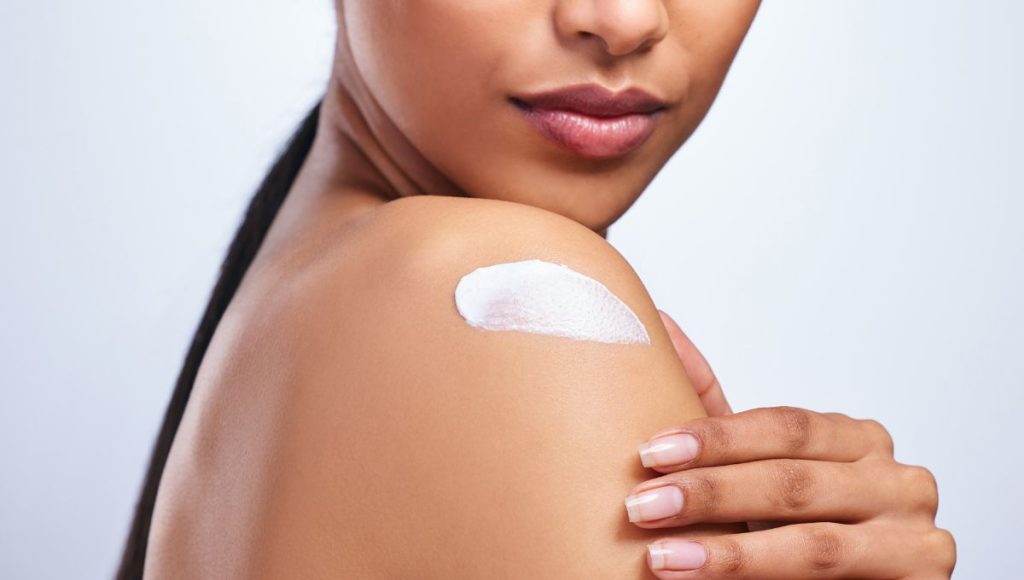
You’ve got the product—now let’s make it work for you. When used consistently and correctly, kojic acid skin lightening cream delivers results that last.
Consistency is your bestie here.
Usage Instructions & Best Practices
Prep. Apply. Protect. That’s the rhythm.
Your easy-to-follow guide:
- Cleanse using a gentle, pH-balanced cleanser (like micellar water).
- Apply the kojic acid cream to dry skin—thin layer only.
- Follow Up with moisturizer or facial oil if needed.
- Sunscreen in the morning is non-negotiable.
Do this nighttime and morning (after patch testing) and… voila.
Tips:
- Start with once daily, then build up.
- Allow it to sit on the skin after applying, don’t rub it off.
- Avoid mixing with harsh exfoliants initially.
- Keep it away from open wounds or scratched skin.
Complement Your Routine: Nasola Triple Acid Facial Radiance Pads
Want boosted absorption and faster brightening? Layer in Nasola Triple Acid Facial Radiance Pads.
These pre-soaked pads:
- Exfoliate dead cells (bye dullness!)
- Contain kojic, mandelic, and salicylic acids.
- Let your cream absorb better.
- Are gentle enough to use 2–3x a week.
Use before the cream—but never on the same night if your skin’s irritated. Listen to your skin. Always.
Extra Care: Combine Kojic Acid with a Consistent Skincare Regimen
Using a kojic acid cream solo gets you somewhere—but combining it with a full, balanced skincare routine? That’s where the magic happens.
Pairing Creams with Serums for Targeted Treatment
Layering is like building a skincare sandwich. The right order → best outcome.
Here’s the hierarchy:
- Toner (optional)
- Serum (like Nasola Kojic Acid Serum)
- Then cream.
This allows the deeply-penetrating serum to prep the skin, while the cream seals and enhances the effect.
Product Feature: Nasola Kojic Acid Serum
The Nasola Kojic Acid Serum is potent but light as a feather.
Benefits:
- Rapid absorption.
- Targets specific areas—sunspots, scars, etc.
- Boosts brightness and collagen.
- Pairs beautifully with the matching cream.
Use this in the morning or night… but especially before special events. Some glows are meant to flaunt ♥️.
Real Talk: What NOT to Do When Using Kojic Acid Skin Lightening Cream

We’ve talked about best practices—but what about the wrong turns? Learning from common mistakes can save your skin (literally) and get you glowing faster.
Mistakes to Avoid
Don’t sabotage your progress. Keep watch for these:
- Overuse: More isn’t better. Start slow.
- No SPF: Kojic acid increases sun sensitivity.
- Layering with harsh actives on the same night (retinol + AHA + kojic = 💥)
- Quitting too soon – it builds over weeks, not overnight.
Remember:
- Skin cycles every 28 days. Real changes show around weeks 4–6.
- Don’t compare your journey.
- Mild tingling? Okay. Burning? Nope.
- Keep it consistent.
Treat your skin the way you want to be treated—with patience, love, and care.
Conclusion
Kojic acid skin lightening cream can genuinely shift your skincare game—especially when powered by thoughtfully crafted formulas like Nasola Kojic Acid Cream.
By targeting melanin production in a steady, gentle way, it addresses dark spots and uneven tone without damaging your skin barrier.
Combined with nourishing ingredients like alpha arbutin, niacinamide, and shea butter—and paired with complementary products like Nasola Kojic Acid Serum and Nasola Triple Acid Facial Radiance Pads—you’re not just lightening skin.
You’re strengthening it. Brightening it. Loving it.
Because when your skin glows?
So do you 🔆.
Frequently Asked Questions (FAQs)
Visible results typically show up between 4 to 6 weeks of consistent use. Results may appear sooner if combined with exfoliants like Nasola Triple Acid Facial Radiance Pads, which promote better absorption of active ingredients.
Look for low kojic acid concentrations (1–2%) paired with hydrating, soothing agents like shea butter and niacinamide. Nasola Kojic Acid Cream is designed with gentle yet effective ingredients ideal for sensitive skin.
Yes, most kojic acid creams like Nasola Kojic Acid Cream are formulated for daily use. However, it’s best to start slowly—apply once every other day—to monitor your skin’s response before increasing frequency.
Generally, yes. Kojic acid is considered safe for ongoing use when part of a balanced skincare regimen. Always pair it with SPF and moisturizers to minimize irritation and sun sensitivity.
Not really. Kojic acid reduces excess melanin production—it doesn’t remove your natural pigment. It helps your skin return to its baseline, even-toned state by minimizing discoloration.
Lotions, like Nasola Kojic Acid Lotion, are lighter and better for covering large areas (arms, legs, back). Creams are richer and ideal for targeted use, especially on the face.
Yes—and it’s encouraged! Start with Nasola Kojic Acid Serum to deeply penetrate pigmentation, then layer Nasola Kojic Acid Cream on top for hydration and sealing effects.
Avoid layering kojic acid with other strong actives like retinol, AHAs, and benzoyl peroxide—especially as a new user. This can lead to over-exfoliation or irritation.
Absolutely. Regular application of Nasola Kojic Acid Lotion on darker areas like elbows, knees, and armpits can result in gradual brightening over time.
Side effects are rare, but mild irritation or dryness can occur. Always perform a patch test and moisturize after use. If discomfort persists, reduce usage frequency and consult a dermatologist.

